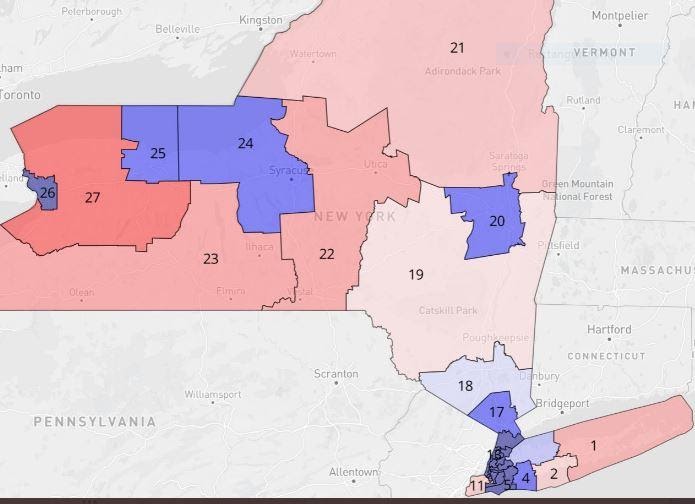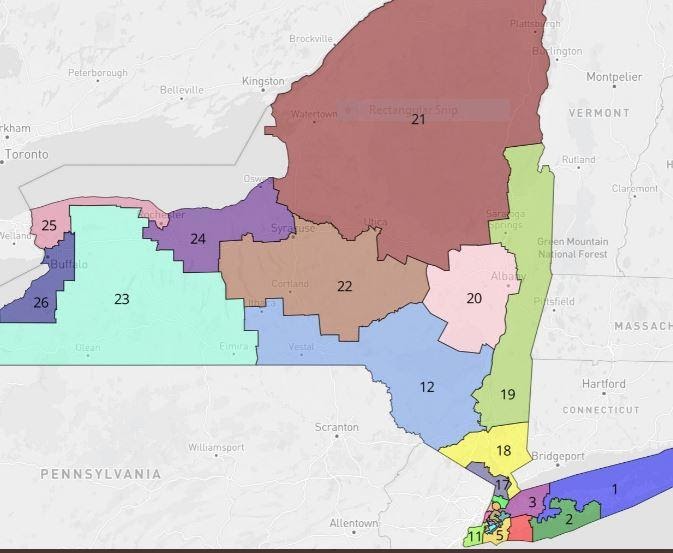Rightsizing the Police Budget will Enable a Safer, Healthier and More Equitable City
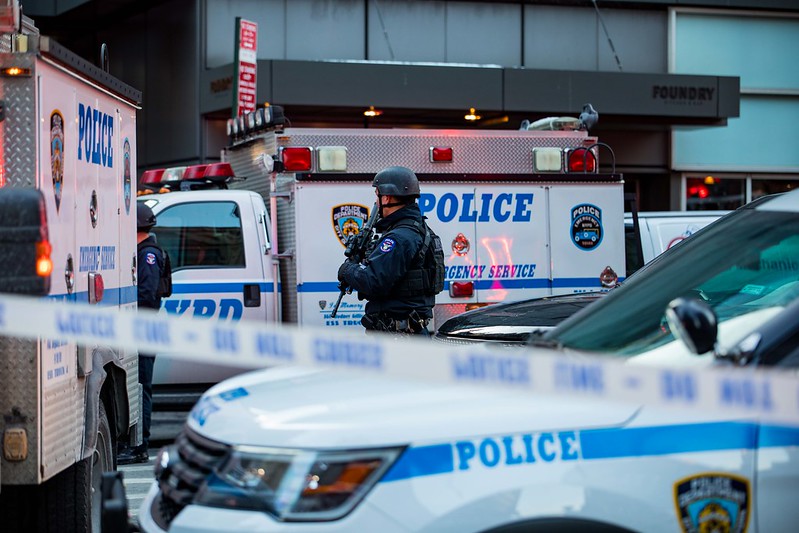
NYPD (photo: Benjamin Kanter/Mayoral Photo Office)
On April 26, Mayor de Blasio presented his executive budget plan for the city’s next fiscal year, FY22, which begins July 1. In it, he included slight increases to the NYPD’s budget. This comes on the heels of the largest civil rights movement in a generation demanding reinvestments and the heartbreaking murders of Adam Toledo and Daunte Wright. If I were in the City Council now, I would fight for a right-sized police budget and deep investments into community care when the adopted budget is agreed upon in June. This is what the majority of New York City Democrats want.
I want to address my neighbors who, like myself, wish to prioritize community safety, but believe that policing is the only way to achieve safe communities. It’s time to have the hard conversations and courage to do what it takes to actually make our city safer, healthier, and more equitable.
To start, let’s unpack just how disproportionate our police budget currently is. The NYPD’s budget is so bloated that it would be the 33rd largest military budget in the world. According to Communities United for Police Reform, for every $1 New York City spends on policing and incarcerating our neighbors, we only spend $0.01 on workforce investment, $0.12 on youth and community development, $0.25 on the Department of Health, and $0.19 on Housing Preservation and Development. If a budget is a statement of priorities, this speaks volumes: we are more interested in policing than we are in investing in healthy, safe communities and programming proven to actually prevent crime.
In the context of New York City’s budget, a “yes” to one thing is always a “no” to something else. Unlike the federal government, New York City must have a balanced budget by law. Every dollar we spend on the NYPD is a dollar we take away from another agency.
With that in mind, here are three ways in which reinvesting city money can make our communities safer and healthier:
1) In 2019, the city spent over $70 million on policing homeless people. This neither solves homelessness nor prevents crime, and reinforces the cycle of homelessness by criminalizing, alienating, or incarcerating those without a home. A far more productive use of that money would be to provide permanent supportive housing with wraparound services to actually help solve homelessness in New York City.
2) We spend over $451 million on police in our school system; meanwhile 45% of schools have had no social workers. Police presence fuels the school-to-prison pipeline, and when a student becomes entangled in the justice system, they are up to four times more likely to drop out. Just last week, I met a constituent whose teen daughter had attempted suicide the month before, and had yet to hear from the school on how she would be supported. Make no mistake; the lack of social workers negatively impacts all of our kids, in every single neighborhood. The mayor announced more investment in social workers for schools, but we can and must go farther.
3) The NYPD spent $96 million in 2019 on drug-related arrests. Arresting someone for drug usage perpetuates harm while doing nothing to solve addiction or keep us safe. Instead of policing users, we should be investing in addiction treatment services, safe injection sites, and overdose prevention. Substance abuse disorder is a health issue, not a criminal or moral one.
There is also a racial justice component to these examples. Black and Latino New Yorkers made up 83.8% of those arrested for drug usage in 2019 despite similar usage rates across races. Black and Latino students made up over 90% of those arrested in the most recent school year, while often coming from the most under-funded schools. In the New York City Department of Homeless Services shelters, 89% of heads of households are Black or Latino. Police violence is a public health epidemic and is a leading cause of death for young Black men in America. So, when we talk about how to invest in community safety, racial justice needs to be of central concern.
Some argue that despite historic pre-pandemic lows, violent crime went up last year, and may use increased gun violence statistics as evidence that we need to keep the police budget intact.
We need to look at the very obvious contexts for the increase in some categories of crime. We are in dire socio-economic and financial straits, with widespread unemployment amidst a year of near-lockdown. Even Republican-led cities that increased their police budgets have seen crime increase at virtually identical rates. Unemployment and economic instability are proven drivers of crime. The answer isn’t more police—it’s to address the root causes of that instability by ushering in deep investments in vulnerable communities.
Nationwide, there is little evidence that shows increased police budgets result in less crime, while there is ample evidence that shows better societal conditions, healthier communities, and widespread employment does reduce crime.
Healthy communities are safe communities. It’s time we prioritize our schools, health care, housing, social services, and the needs of our city’s workers while building a future where solutions are rooted in community care and justice.
***
Aleda Gagarin is a mother, non-profit leader, community activist, and City Council candidate running in the 29th District in Queens to represent Forest Hills, Kew Gardens, Rego Park and Richmond Hill. On Twitter @AledaGagarin.
***
Have an op-ed idea or submission for Gotham Gazette? Email This email address is being protected from spambots. You need JavaScript enabled to view it.
‘Open Restaurants’ Shouldn’t Close Them Down
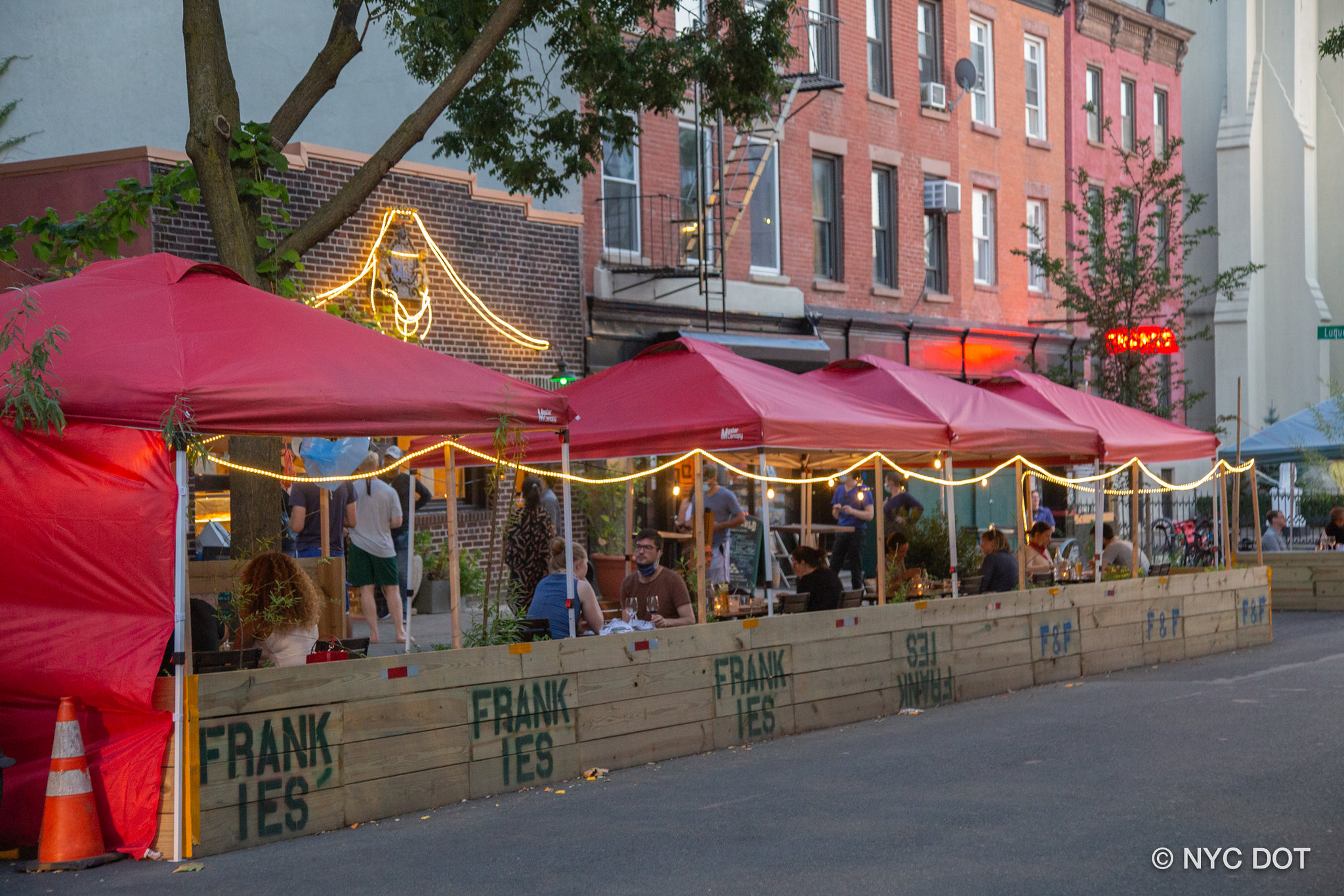
Outdoor dining (photo: @NYC_DOT)
Surviving as a restaurant in New York City was never easy. But more than a year of indoor dining restrictions and the economic ruin of a global pandemic brought many restaurants that were able to hold on to the brink of bankruptcy. That is why we cheered when the city announced the permanent extension of the Open Restaurants program back in September, preserving an estimated 90,000 jobs by letting more restaurants serve customers outdoors.
If properly implemented, Open Restaurants should help lessen the pandemic’s economic impact on business owners and restaurant workers, including women, people of color, immigrants, and New Yorkers of all stripes who work in the restaurant industry. Unfortunately, the program has proved costly for the restaurant owners it was meant to help. It’s time for the city to fix it.
Open Restaurants has been plagued by challenges from the start. Restaurants had to use their remaining cash to build outdoor structures for their customers. Then came a cascade of costly, chaotic rules and regulations that changed month to month. The rollout of the safety barrier policy – intended to safeguard patrons from the danger of passing cars – left owners frustrated after the city failed to provide the free barriers it promised, only to then change its mind regarding what types of barriers were sufficient. Many restaurants had to pay out of pocket to construct, and then re-construct, their own barriers at a time when they could barely afford to keep their staffs employed.
Six months after the program was made permanent, problems persist. Restaurant owners report that inspectors aggressively and inconsistently fine and issue cease and desist orders to “out of compliance” restaurants with hardly any time to remedy the violation.
Rather than regulating restaurants into ruin and their workers into unemployment, our city should bolster the Open Restaurants program so that it actually works with restaurants, rather than against them.
First, the city should provide restaurants with the clear guidance and resources they need to protect patrons. The city should actively engage restaurant owners to understand the hurdles they faced during the initial rollout of the Open Restaurants program; their direct feedback will better inform a regulatory framework that supports restaurants and keeps patrons safe.
Second, the city should not enforce cease and desist orders against restaurants that make a good faith effort to comply with regulations. A cease and desist order can kill a business by forcing it to shut down, at least temporarily putting staff out of work. As long as restaurant owners are taking active steps to comply with the regulations, they should feel secure in the certainty that they will be able to stay open. The New York State Liquor Authority should also adopt a similarly transparent, fair, and consistent enforcement approach to liquor licensing.
Finally, going beyond the Open Restaurants program, the city must codify its commitment to restaurants and small businesses alike. The Mayor just announced a $159 million investment in small business recovery and job training; we should increase this funding so that resources are available for small businesses in all of our communities and beyond this coming fiscal year. More so, at a time when thousands are still looking for work, we should invest additional funding in Apprentice NYC, a program that helps New Yorkers learn skills in industries including food service. Let’s also make sure our small business owners are aware of these programs by committing to direct outreach and informational campaigns.
As the city works to fully reopen and support small businesses, it must take a comprehensive and thoughtful approach to address the Open Restaurants program’s flaws. Before the pandemic, the city’s 23,000 restaurants and bars employed 1 out every 12 private-sector workers in New York. The Open Restaurants program is our chance to save this vital industry. Let’s make it stronger, so our restaurants can safely declare themselves open for business.
***
Mark Levine is currently the City Council member for Manhattan’s District 7 and Chair of the City Council Health Committee. He is running to serve as Manhattan’s next Borough President. Shaun Abreu is a tenants’ rights attorney who represents low-income families from Northern Manhattan in housing court, and a candidate for City Council in Manhattan’s District 7. On Twitter @MarkLevineNYC & @ShaunAbreu.
***
Have an op-ed idea or submission for Gotham Gazette? Email This email address is being protected from spambots. You need JavaScript enabled to view it.
Manhattan DA’s Own Data Proves Racist Prosecution Fuels Mass Incarceration in New York
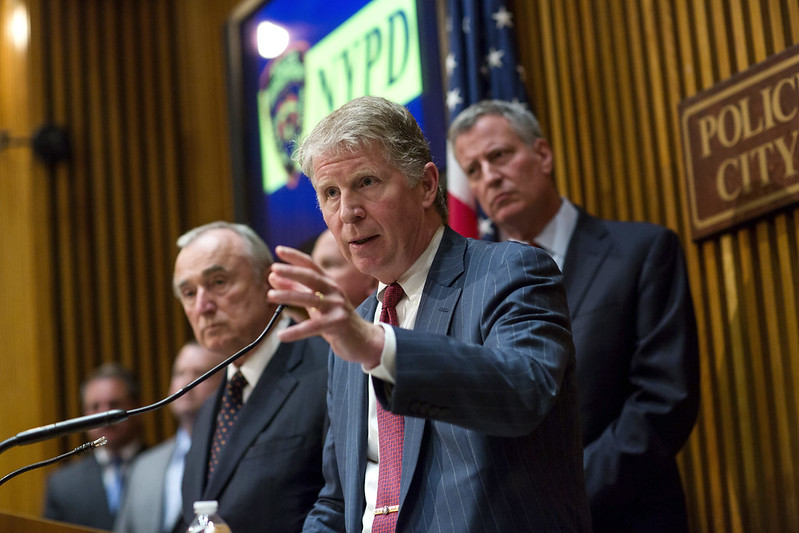
Manhattan DA Cy Vance (photo: Ed Reed/Mayor's Office)
As I write this many are breathing a sigh of relief for the guilty verdict returned in the trial of Derek Chauvin. However, we must not forget that prosecution is an intrinsic part of the racist law enforcement regime that resulted in the death of George Floyd, Breonna Taylor, Daunte Wright, Adam Toledo, Ma’Khia Bryant, and hundreds of others killed by police officers in the last year.
In June, Manhattanites, myself included, will vote in the primary for the top cop in Manhattan—the District Attorney—and it’s long past time we examined how this office perpetuates violence through mass criminalization and incarceration right here at home.
New York City invests millions of dollars into prosecution, yet district attorney offices are purposefully opaque about their decision-making and the scope of harm they inflict on communities of color. Through my work at the Brooklyn Community Bail Fund and our court watching program, Court Watch NYC, I have become intimately familiar with the trauma, abuse, and torture carried out by district attorney offices.
In Manhattan District Attorney Cy Vance’s courtroom, I’ve seen families torn apart by pretrial detention, people shackled and held to ransom for bail, and parents waiting in fear, hoping their children can come home. Yet, this only scratches the surface of the harm that prosecutors cause Black and brown communities.
Last month, District Attorney Vance released data on Manhattan prosecutions dating back to 2013. Vance’s data dump provides evidence of racism inherent to a system over which the Manhattan DA holds considerable power. An analysis of data from Vance’s own dashboard shows that in 2020 his office was 43% more likely to request bail and 25% less likely to decline prosecution if the person accused was Black or Latino. Black and Latino people are also more likely to be jailed pretrial in Manhattan and incarcerated if convicted. This, along with data from the New York City Department of Correction that show one-third of the current daily population in New York City jails come from the borough of Manhattan, further demonstrates that the Manhattan DA’s office is a driving force of mass incarceration in New York City, funneling mostly Black and brown people through a system that destabilizes communities, separates families, and upends—or takes—lives.
Despite Manhattan experiencing a 50% reduction in case intake between 2013 and 2019—largely due to the organizing efforts of directly impacted New Yorkers to limit Vance’s discretion to lock people up—the office’s budget and staffing have actually grown. The Manhattan DA’s budget now stands at a whopping $147 million, not including over $700 million the office holds in forfeiture funds, which it uses to target poor and working class communities of color.
While the data dashboard shows the harmful impact of the district attorney’s office on Black and brown communities and the need to significantly reduce the office’s size, scope, and resources, it is a far cry from what Vance claims is a “groundbreaking move toward transparency.” As with any packaged data, its authors curate what they choose to show and what information they keep to themselves. Without unfiltered case-level data, Vance's dashboard is only the tip of the iceberg. What's below the waterline?
Recognizing that prosecutors can never deliver the justice Black and brown communities need, at the very least, every district attorney in New York City should be required to produce anonymized case-level data. Only then would the public begin to glean the full scope of prosecutors’ impact on communities of color. Each candidate for Manhattan District Attorney should commit to continuing what Vance has started here, go further by including the underlying anonymized case-level data, and ensure that all of their office policies and practices are aimed at shrinking the size of a violent carceral system, including the office itself.
In the meantime, DA Vance should use the remainder of his tenure as Manhattan District Attorney to address the violence his office has caused individuals, families, and communities for over a decade and reduce prosecutions moving forward.
***
Zoë Adel is the criminal legal advocacy manager at the Brooklyn Community Bail Fund.
***
Have an op-ed idea or submission for Gotham Gazette? Email This email address is being protected from spambots. You need JavaScript enabled to view it.
New York’s Congressional Redistricting Could Be Tipping Point in Midterm Battle for Control of the House
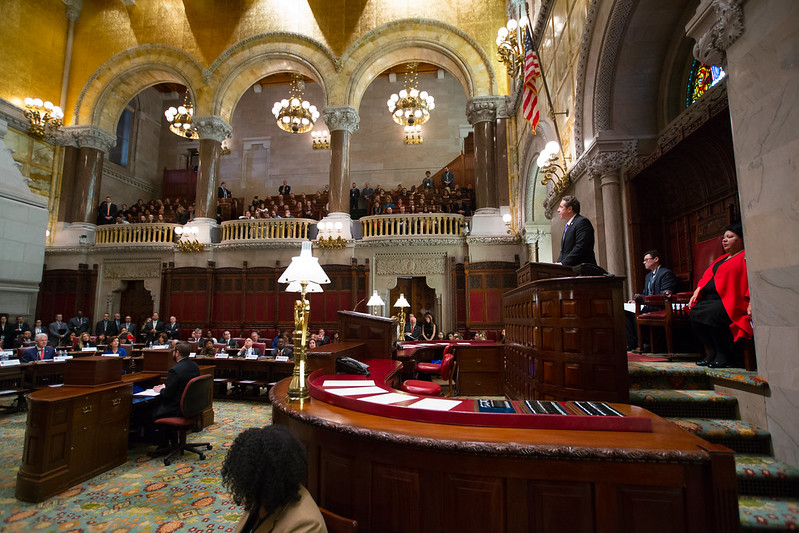
State Senate chambers (photo: Philip Kamrass/Governor's Office)
The Census Bureau released its population counts for the nation and the states on April 26, including changes for the states in the apportionment of 435 seats in the United States House of Representatives. New York State will drop one House seat, going from 27 seats to 26, even though it actually gained more than 800,000 people, from 19.4 to 20.2 million, since 2010. Extraordinarily, the Census reported that New York would have held its 27th seat if 89 more persons had been counted.
The changes come at a time when the Democratic majority in the House is deeply threatened. Historically, the party in power (this time, the Democrats) loses seats in the midterms, the congressional elections halfway through a president’s term. This is a fact Democratic President Joe Biden is surely keenly aware of given his long political history in the U.S. Senate and as Vice President.
The Republicans have more power over drawing new state district maps than the Democrats do because they have more “trifectas,” where one party controls both houses of the state legislature and the governor’s office. The Republicans now have 23 states with trifectas compared to 15 for the Democrats, including New York. These national Republican advantages mean the outcome of redistricting in New York could be vital to the Democrats holding the House of Representatives. Democrats now dominate both Houses of the New York State Legislature and have the power to eliminate a number of Republican House seats, despite the existence of an Independent Districting Commission created to make redistricting fair to both political parties.
The apportionment changes across the country were less dramatic than anticipated, although the shift in the allocation of House seats continued to the South and the West. New York and a handful of other states will lose one seat each. Texas will gain two, and Florida, Georgia, North Carolina, Montana, Colorado, and Oregon gain one each. The apportionment changes, however, are just a prelude to the national power struggle over redistricting. The 2022 midterm elections for control of the House of Representatives will take place on the new district lines drawn by the states.
Some states have set up nonpartisan commissions to achieve fair districts; in some states one political party has a trifecta and has only the exercise of self-restraint to curb ruthless partisan gerrymandering. In other states, divided government, where there’s some political split within the two houses of the legislature and governor’s office, can result in political compromises in the drawing of the lines. Virtually every districting plan ends up challenged in the courts, whose decisions can sometimes, but not always, act as a final restraint on partisanship.
Partisan gerrymandering of legislative districts is virtually synonymous with redistricting itself, and is well known to the general public. Gerrymandering has been a political fact of life since the early 19th century and includes state and local districts as well as the House of Representatives. Both parties historically have gerrymandered where they had the power to do so, but the 1960s produced some restraints on the process, like the Voting Rights Act and the one-person, one-vote 1964 decision of the United States Supreme Court.
New York State has been no stranger to partisan gerrymandering, but there was a division of power in the state for decades, with Republicans in control of the State Senate and Democrats in control of the State Assembly. The division of power forced compromises on the House seats, but for the state legislative districts in the Assembly and the Senate the party in power controlled the process. Voting Rights Act and one-person, one-vote protections, as well as court challenges, continued to force modest restraints on partisanship, and elections always produced unique results. In my 32 years in the State Legislature, I went through three redistrictings, in 1992, 2002, and 2012. They were never fun, even for a Democratic incumbent Assembly member from Brooklyn.
Demands for greater fairness in the process finally produced a constitutional amendment in New York creating an independent redistricting commission in 2014. I voted for the legislation that put the constitutional amendment on the ballot after the 2012 redistricting of the House seats and legislative districts. The Republican Party still controlled the State Senate in 2012 and 2014 but the Democrats were becoming ever more competitive. The Democrats in the State Senate gained an outright majority against the Republicans in 2016, gained more seats in 2018, and in 2020 won 43 out of the 63 seats in the Senate, or more than two-thirds of that body. Democrats in the State Assembly have had two-thirds majorities for decades, primarily because nearly every single one of the 65 Assembly districts in New York City is represented by a Democrat.
In the past decade, the United States Supreme Court, in two major decisions, undermined the fight for fair processes in redistricting, despite the creation of a number of independent districting commissions in the states. In 2013, in Shelby County v. Holder, the U.S. Supreme Court threw out the preclearance of district maps of the states by the Justice Department under Section V of the Voting Rights Act, claiming Section V was no longer necessary. In 2019. the U.S. Supreme Court, in Rucho v. Common Cause, halted the efforts to reform partisan gerrymandering in the federal courts, saying gerrymandering was ultimately a political question over which the federal courts did not have authority.
The Supreme Court decisions have now left the door wide open for ruthless racial and partisan gerrymandering over House districts, especially in the southern states like Texas, Florida, Georgia, and North Carolina (the Democratic Governor in North Carolina has no role in redistricting there), which the Republicans control and where there is no longer preclearance by the Justice Department to halt racist gerrymanders.
Dave Wasserman, a political analyst for the Cook Political Report and one of the nation’s foremost experts on redistricting, has examined the state of redistricting across the nation. His analysis presents the current status as follows for the 435 House seats across the country: 187 seats with districting controlled by Republicans, 75 controlled by Democrats, 121 under independent/bipartisan districting commissions, 46 seats under divided party control, and 6 at-large seats. In some states, however, like Florida, the Republican Party is likely to aggressively draw new lines to eliminate Democratic incumbents and shore up newly-elected Republicans from South Florida. As many as 3 Democratic House seats are at risk there.
There are likely to be aggressive efforts to draw the district lines where one party or the other controls the process, but the fact remains that the Republican Party is in control of more states than the Democratic Party. The Republicans, just through redistricting alone, are capable of eliminating enough Democratic seats across the country on a net basis to offset the current 222-213, thin, five-seat majority the Democrats have in the House, making it ever more challenging to hold House seats for the Democrats in the midterm elections. In addition to New York, other important states like California, Ohio, Virginia, and Michigan have districting commissions that could neutralize partisanship. But even in those states the outcome is far from certain.
At the national level, there is still a chance that Congress could put the brakes on partisan or racial gerrymandering. H.R. 1, which has been passed in the House, requires non-partisan districting commissions for Congressional districts, and uniform standards for fair districting, like geographic compactness and communities of interest. H.R. 4, the John Lewis Voting Rights Advancement Act, would restore Section 5 of the Voting Rights Act and re-establish Justice Department preclearance of district lines. A version of H.R. 4 passed in 2019. These bills, advanced by Democrats, proffer a truce on redistricting to the Republicans, a chance to avoid an all-out war over district lines. The demographic data and individual population counts for each district, information essential for the lines to be drawn, won’t be released until August. The redistricting will then begin in earnest. There is still time to negotiate, but in my opinion Republican acceptance of reforms is unlikely.
The design of New York’s redistricting commission still puts the Legislature in ultimate control in a set of circumstances that have already come to pass. The plans submitted by the commission to the Legislature can be rejected twice, and, upon two-thirds vote of each house, the Legislature can then draw the lines.
Democrats currently have a 19-8 majority in the New York House delegation, and the state must lose one seat.
Compliance with certain standards in New York’s law on redistricting, such as compactness and communities of interest, must be adhered to regardless of whether the commission or the Legislature draws the district lines in New York. Every Congressional district must have about 760,000 people, and it is not yet known how many persons are within each district or what their minority populations are, but House Speaker Nancy Pelosi, among many others, is probably vitally interested in what the final lines will look like in New York.
Wasserman, in a set of New York maps put out on his twitter account, depicted New York’s current lines and envisioned a districting alternative that eliminates five Republican districts. New York goes from a 19-8 Democratic majority to 23-3. See below for more.
New York’s current district map from @redistrict April 27, 2021:
New York’s Republican House districts are 1, 2, 11, 21, 22, 23, 24, and 27. Republican Congressional Reps. Lee Zeldin from the 1st C.D. just launched a campaign for Governor in the 2022 election and Tom Reed from the 23rd announced he is retiring, meaning two Republican-held seats are likely to be vacant.
Here is Wasserman’s concept for a redistricting in New York that goes to 26 seats and has a 23-3 template for Democratic wins:
The above map is just a concept. But the Democrats have enough flexibility shifting Democrats around to take all three of the Republican seats downstate (two on Long Island and the Staten Island-Brooklyn seat), and convert them into winning districts for Democrats. That would leave three Republican seats in Upstate New York instead of five.
Partisan maps don’t guarantee victories in elections. No one knows what the overall national tone will be like in the fall of 2022. Will Biden stay popular? Will there be a conservative counter-reaction to Democratic spending, leading to a Republican wave like the Tea Party in 2010? Will Democrats in New York (and elsewhere) go to sleep and fail to come out to vote? The answers to these questions are unknown. But I think if the legislative leaders in New York offered Nancy Pelosi an elimination of five Republican seats I know what her answer would be.
***
Jim Brennan was a member of the New York State Assembly for 32 years, where he chaired four committees. On Twitter @JimBrennanNY.
***
Have an op-ed idea or submission for Gotham Gazette? Email This email address is being protected from spambots. You need JavaScript enabled to view it.
Accountability, Respect, and Safety: Policing in New York City After the Chauvin Verdict
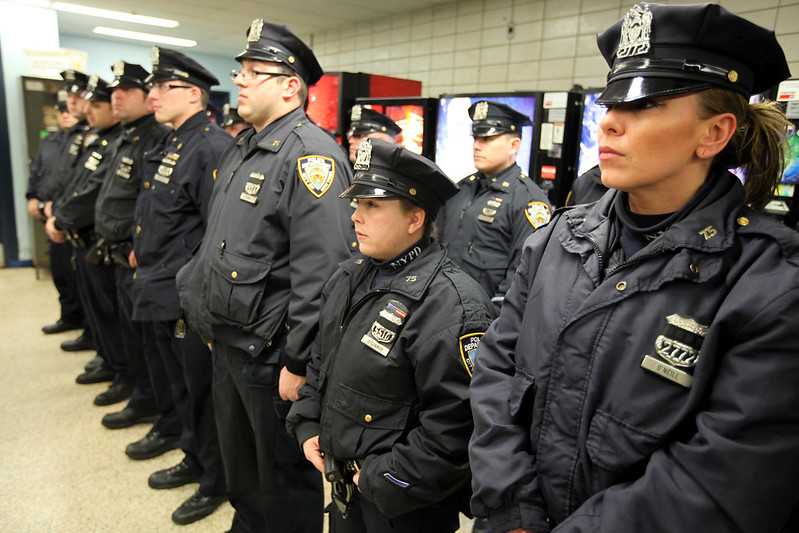
NYPD officers (photo: Ed Reed/Mayor's Office)
The conviction of former Minneapolis Police Officer Derek Chauvin for the murder of George Floyd provides some comfort to all of us that no one is above the law.
Patrick Lynch of the Police Benevolent Association (PBA), the union representing front-line New York City police officers, said it clearly. “What Derek Chauvin did that day was not policing,” Lynch said after the verdict was announced. “It was murder.”
The verdict has re-energized a debate, nationally and here in New York City, about policing and the role police play in maintaining fair, effective, and unbiased public safety on our streets. Where I differ from my colleagues in this year’s Manhattan District Attorney Democratic primary race is my understanding and embrace of the fact that the NYPD is an essential and irreplaceable partner in rebuilding trust between communities and the police force. The demonization and demoralization of men and women in blue hurts all of us in every corner of the city.
Rebuilding that trust includes recognizing the reality of racism, whether overt or implicit bias, inside and outside of police departments, which reflect the broader challenges racism poses in the society at large.
I have spent two decades in public safety on both sides of the courtroom, as a prosecutor under the late Manhattan District Attorney Robert Morgenthau and for the last 12 years as a defense attorney. Nobody is above the law — not police officers or anyone else. That is why voters must look for a District Attorney with the judgment and commitment to initiate criminal prosecutions against police officers when justified and appropriate.
But voters must also look for a District Attorney who understands that public safety is a team effort, including community leaders and residents, other elected officials, and of course the NYPD officers themselves who work every day to maintain safety and security. That means understanding that some of the same communities where activists have been most vocal in calls to defund the police are the same communities that bear the burden of being the most victimized by crime.
Lynch is right to call for an “honest discussion of policing and public safety that begins with the real challenges we face on our streets.”
And I agree with the calls to rationalize and humanize our criminal justice system, and to provide offenders a path to a productive life once they have served their sentences. That is why, for example, I applaud the recently passed bill in Albany to restore voting rights to parolees to help them reintegrate into society.
The hallmark of effective law enforcement and public safety requires balance and accountability across the board – for police officers such as Chauvin, but also for the Assistant District Attorneys I will supervise, and for the offenders who commit crimes on the streets of Manhattan, undercutting the quality of life for all of us. I applaud the conviction review units in various District Attorneys’ offices around the city that have led to the vacating of past convictions based on unfair trials, freeing inmates from an injustice that taints that trust in public safety we must all be committed to restoring.
It also means well-intentioned reforms in bail have gone too far. It is one thing for someone accused of committing a misdemeanor, for example, to be released on their own recognizance for the first, or even a second, offense. But when the same person is arrested for a third or fourth or fifth offense, as happens with distressing frequency, that accused offender should be put through the system and brought before a judge who can assess if bail is appropriate and whether intervention for mental health or substance abuse issues would be best for the accused and for the community where the offenses were committed.
And it means a rejection of ‘defund the police’ rhetoric, which the Rev. Al Sharpton has characterized as “latte liberalism” reflecting the ideological predilections of some activists who do not have to live with the constant threat of crime that so many in communities of color face on a daily basis.
Reallocating police resources to agencies better equipped to handle issues involving homelessness and mental health, for example, makes sense, though not at the expense of public safety.
Ultimately, restoring public trust requires that we recognize that we are all in this together, including the police officers we depend on to keep our streets safe.
***
Liz Crotty is a Manhattan lawyer and Democratic candidate for Manhattan District Attorney in the June primary election. On Twitter @LizCrotty2021.
***
Have an op-ed idea or submission for Gotham Gazette? Email This email address is being protected from spambots. You need JavaScript enabled to view it.
Tech Jobs in the City are Growing; Here's How to Make Sure New Yorkers Can Fill Them
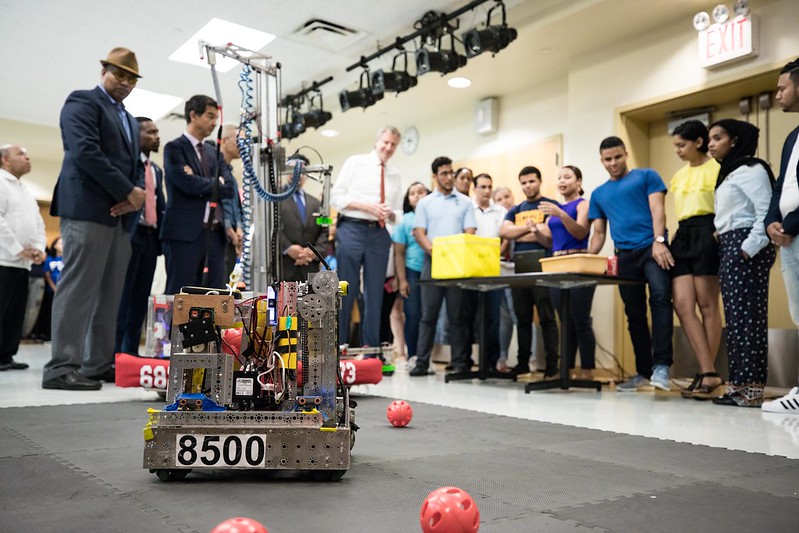
Robotics and tech ed (photo: Benjamin Kanter/Mayor's Office)
With more than half-a-million New Yorkers out of work amid a painful economic downturn, the continued growth of tech positions stands out as a beacon of economic recovery. Connecting more residents with these jobs presents an important opportunity for the next mayor to get New Yorkers working again.
Despite months of grim economic news, tech firms have continued to double down on New York City. Over the past year, companies including Google, Facebook, Apple, Amazon, and Netflix have signed new leases, ramped up hiring, and invested millions of dollars in the city.
This deepening commitment is reflected in the latest hiring data: Since the pandemic hit, new research reveals that New York City employers have posted more openings for tech roles than any other job category—over 67,000 in all. In total, nearly one in five (18%) jobs posted from April to November 2020 was for a tech position. That’s greater than the demand for healthcare jobs, more than double that of finance positions, and almost five times larger than hospitality or education. And the growth of tech roles isn’t limited to the tech sector, but threaded across nearly every part of the economy, from health care and education to finance, media, transportation, and manufacturing.
But far too few of the most economically vulnerable New Yorkers and their families—from young children to out-of-work adults—have access to high quality computing education or in-depth training for tech careers. As a result, many of these good jobs remain out of reach for New Yorkers with the most to gain.
To rebuild a more equitable city in the months and years ahead, this will have to change.
The city’s next mayor, elected this year to take office January 1, should launch a bold, long-term plan to expand and improve the tech skills-building ecosystem, backed up by significant new public investment. An expansion of both career training and K-12 computing education can help dislocated workers get on the path to in-demand occupations and ensure that future generations of New Yorkers build computational thinking skills as part of a sound basic education.
Policymakers face an enormous need—and an important opportunity—to make those crucial investments now. After a year of virtual schooling, the need for investment to close the city’s digital divide has never been clearer. The Department of Education (DOE) deserves credit for distributing more than 320,000 devices to students and improving WiFi connectivity, but the problem extends far beyond hardware. Too many schools lack quality computing education at all grade levels, and too many teachers and administrators were ill-prepared to manage the transition to virtual learning. The opportunity divide is growing as a result.
That’s why the next mayor should commit to a new level of investment in K-12 computing education: preparing New Yorkers to pursue STEM degrees at CUNY and to succeed in training programs for tech careers. The newly-adopted 2021-2022 state budget presents an important opportunity to do just that by allocating more than a billion dollars in long-sought additional education funding to New York City. City leaders should use this funding to ensure that every student can experience effective, age-appropriate computing education.
It starts with building on—and going beyond—the success of the city’s Computer Science for All (CS4All) initiative, which has embedded computer science education in more than 825 public schools since 2015. The next mayor should champion the program’s expansion to reach every student by 2025 and ensure that DOE has the institutional support and accountability to keep on pace.
Next, city leaders should focus on expanding computing education in grades K-5, where current offerings are limited. Early exposure to foundational computing education can help close achievement gaps for low-income students and shape early attitudes toward technology careers. The next mayor should lay out a vision for universal computing education.
To accomplish this, the city should also invest in professional development and pre-service training in computing education, building on a promising pilot program at CUNY. That way, every teacher can gain the tools needed to integrate computational thinking into their classrooms.
The challenges fueled by the pandemic have also exacerbated preexisting holes in the city’s tech skills-building ecosystem for adults. Fortunately, New York City is home to a number of high-quality tech training programs that consistently lead to good jobs for New Yorkers from underrepresented communities. But most of these programs serve from a few dozen to a few hundred people annually, when New York needs to be reaching thousands. The next mayor needs to scale up these effective tech training programs to reach their full potential.
At the same time, far too many New Yorkers from low-income communities lack the literacy, numeracy, and digital skills needed to qualify for the best tech training programs . The next mayor needs to build a new infrastructure of bridge programs, providing onramps to tech career training for those without a high school diploma or with limited English proficiency.
In addition to skills needs, cost barriers prevent New Yorkers from accessing workforce development programs—even ones that are tuition-free. The city should step up its support for the many non-tuition roadblocks to career advancement, from lack of childcare or at-home WiFi to the cost of transportation, and incentivize providers to collaborate on wraparound services.
A deep and diverse talent pool will help ensure that tech-powered industries can stay here and grow, while producing good jobs for New Yorkers. To tap this powerful opportunity, the next mayor should make a long-term investment in K-12 computing education and tech career training, equipping every New Yorker with the skills, tools, and opportunities they need to thrive in a digital world.
***
Eli Dvorkin is editorial and policy director of the Center for an Urban Future. Amber Oliver is managing director of Robin Hood Learning + Technology Fund. On Twitter @nycfuture & @RobinHoodNYC.
***
Have an op-ed idea or submission for Gotham Gazette? Email This email address is being protected from spambots. You need JavaScript enabled to view it.
10 Reasons to Oppose 'Albanycare'

(photo: Kevin P. Coughlin/Office of Governor Andrew M. Cuomo)
Lawmakers in Albany are again advancing the New York Health Act, which would abolish private health insurance and herd all New Yorkers into a state-run “single payer” plan financed with massive tax hikes.
Instead of building on recent progress—which has brought us closer than ever to universal health care coverage—this proposal would demolish the current system and put one-fifth of the economy under state control.
Here are 10 reasons why “Albanycare” is the wrong way to go.
It’s a Major Leap of Faith
Instead of modeling their plan on an existing system with a track record, the authors are attempting something radically different: a 100% tax-funded health plan, covering everyone and everything, with no limits on choice of provider, no premiums or copayments, and no private alternatives allowed. Nothing quite like it has ever been tried before—in the United States or anywhere else.
It’s Unnecessarily Disruptive
As of 2019, New York’s uninsured rate had dropped to a historic low of 5%, or about 1 million people, many of whom are eligible for existing programs. That puts universal coverage within reach through relatively modest investments and policy fixes. With a conversion to single-payer, the vast majority of the cost and effort would be focused on people who already have coverage—and who are by and large content with it. A single-payer system would also redistribute resources among providers, creating winners and losers with unpredictable effects on the stability of the system.
It Will Break the Bank
Even if you believe the new system can cover more people and more benefits at roughly the same cost (which is dubious in the extreme) this proposal would put the entire $300 billion health system on the state’s balance sheet—making the rest of government look small by comparison. At a minimum, the price tag could be expected to grow at roughly the rate of medical inflation year after year. Figuring out how to balance the budget of this one program—by cutting costs, raising revenue or both—would become Albany’s dominant obsession. Some level of rationing would be almost inevitable. Lawmakers would face choices between reducing payments to providers or limiting benefits.
It Requires Economy-Busting Tax Hikes
Financing single-payer—even at a cost-neutral level—would require state tax hikes on a scale never before seen in U.S. history. Some lower-income New Yorkers might save money compared to premiums, but only because their higher-income neighbors would pay drastically more. Those hardest hit by the taxes would be incentivized to move away, triggering a spiral of falling revenue and soaring tax rates. The state’s ability to raise money for other priorities—such as mass transit or renewable energy—would be diminished if not eliminated.
It Lacks Viable Cost Controls
The proposal would abolish existing restraints on spending (as flawed as they may be) without clearly identifying alternatives. For starters, most reimbursement would be on a “fee for service” basis, a model that encourages over-consumption—and rewards bungling providers by paying them twice, first to make the mistake, and then to fix it. The promise of “free” service without a consumer contribution, and without other constraints imposed by health plans, would encourage excessive use of certain tests and treatments, including many with limited or dubious value.
It’s Authoritarian
The bill mandates state-sponsored coverage for all New Yorkers, whether they want it or not, while effectively banning private insurance and private fees. Imagine imposing that level of government control over other necessities such as food, housing or education.
It Gives New Yorkers More Reasons to Leave
Wealthy individuals and businesses can easily avoid the new single-payer taxes by setting up residence in another state. People of even modest means who are happy with their current coverage might choose to live elsewhere. Medical providers who do well under the present system might decide they’re better off leaving. On the other hand, the offer of free long-term care would incentivize people to move here just before they enter a nursing home or seek other costly services.
It Leaves Too Many Questions Unanswered
The bill is long on promised benefits but short on details about the trade-offs. The most consequential decisions—starting with where to set tax rates and how to compensate providers—are left to be determined by future legislators, a future governor and a future panel of appointees. Nor has the proposal been subject to a full-fledged analysis or proper public hearings. Lawmakers should do their homework before passing what would be the most complicated and high-stakes program in state history.
It Depends on Trusting Albany
Running a health plan for 20 million people demands a level of competence and honesty that the state government has never demonstrated before. For a preview, look no further than New York’s Medicaid system, which is hugely ineffici ent and riddled with waste and corruption. Time and again, Albany puts the interests of players in the system—especially those who can afford lobbyists and campaign contributions—over the needs of the vulnerable people Medicaid is supposed to serve.
It’s the Wrong Response to a Pandemic
The best way to fight a viral outbreak is to prevent it from spreading in the first place. That’s primarily the job of the public health system—which focuses on entire populations rather than individuals and does not depend on insurance companies for money. Doctors, hospitals, nurses, etc., play the essential role of treating those who do become sick, but they’re not the ones who order quarantines, limit crowd sizes, shut down non-essential businesses or mandate mask-wearing. Most hospitals and doctors became less busy during the height of the pandemic, to the point that many hospitals furloughed employees and needed financial bailouts. When hospitals did become overwhelmed with patients, it wasn’t because people lacked coverage, but because the public health system had broken down.
***
Bill Hammond is senior fellow for health policy at the Empire Center. On Twitter @NYHammond.
***
Have an op-ed idea or submission for Gotham Gazette? Email This email address is being protected from spambots. You need JavaScript enabled to view it.
Investing in People in Prison is Good Policy — I Know from Experience
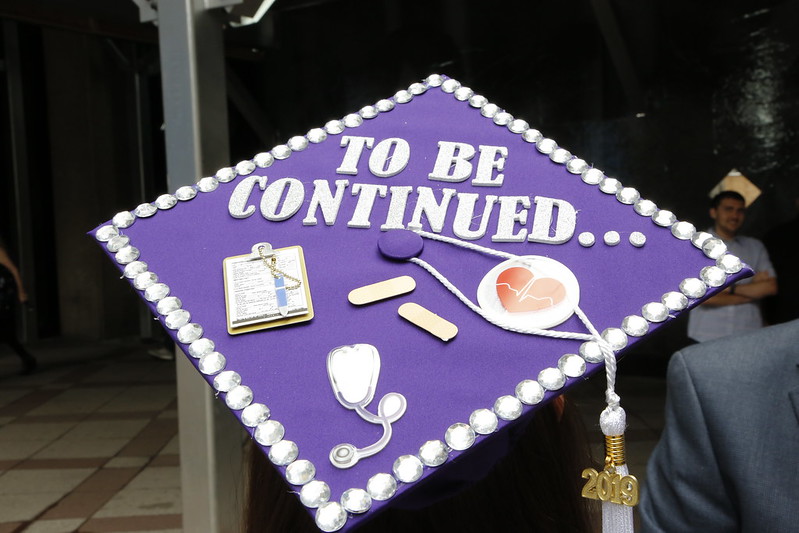
College graduation (photo: CUNY)
Abolitionist Henry Ward Beecher once said: “We should not judge people by their peak of excellence; but by the distance they traveled from the point where they started.” While my travels didn’t include the cobblestone streets and dirt roads of Beecher’s Gilded Age Brooklyn, his words certainly resonate. Although today I’m an incoming law student at Yale, I “started” in the redbrick labyrinths of Brooklyn’s multi-story housing projects. For me and many other Black youth of the 1990s, the calaboose-like atmosphere of New York City’s public schools sowed ignominy and self-doubt. “Zero tolerance” was more than just a catchphrase, it was as real as the metal detectors and uniformed police we encountered every day.
It should come as no surprise, then, that I was incarcerated before the age of 21.
Reportedly, Black high school dropouts face 7-in-10 odds of going to prison by their mid-thirties. I was no exception. When I entered prison in 2000, New York’s overall investment in rehabilitative programming had already waned. The declining emphasis on rehabilitation coincided with a national trend toward harsher punishments. Beginning in the 1990s, as incarceration rates grew, state and federal resources were being diverted from educational programming in prison. In 1974, there was one educator or vocational instructor for every 53 incarcerated people, and one for every 67 in 1990. By 2005, however, there was one educator for every 112 incarcerated people. In contrast, the number of security hires within that 30-year period remained largely proportionate to the growing prison population. Our national priorities around crime were quite obvious, and reform through education simply did not make the cut.
Perhaps the most salient disinvestment in prison education was the 1994 Crime Bill, which ended federal Pell grants for incarcerated students. In 1995, New York’s Republican Governor, George Pataki, followed suit and eliminated tuition assistance for incarcerated students. This decimated college programming throughout New York’s prisons, reducing the total number of incarcerated students to just under 2%. The programs that remained were privately funded and scarce.
The prison I spent 17 years in didn’t have a degree-conferring college program until 2016, the year before I was released. Once out, I continued with my classes through independent study and later matriculated at Cornell in 2018. I graduated in 2020 and will begin law school in the fall.
College transformed my life. Like nothing else, it let me know society was willing to give me a second chance—that my road to redemption was no fool’s errand. Honestly, I don’t know where I’d be without college. And yet, over 98% of folks inside New York’s prisons are without it. Fortunately, Congress recently reinstated Pell grants for incarcerated students, and that’s a big step in the right direction. New York, however, is lagging behind.
Despite the Democratic super-majorities in both houses of the state Legislature, New York’s ban on tuition assistance—known as TAP—for incarcerated students remains a relic of the failed policies of the 1990s. To date, college enrollment in New York’s prisons has remained dismal even with the increased aid offered by Second Chance Pell, which temporarily restored Pell grants for qualifying programs. As it stands, less than half of New York’s prisons offer college, and programs can enroll only a fraction of eligible students at the prisons that do. This is especially harsh given that New York law allows people to leave prison six-months earlier if they earn 24 college credits. But dangling a ‘carrot’ you’re unwilling to buy with your own buck isn’t sound policy, it’s irresponsible.
One of the most rewarding parts of my college journey was witnessing how it inspired my nephew, Darryl. He was just months away from graduating high school when I was released. As a child, he lived in Brooklyn’s Howard projects, in Brownsville—where the popular motto is “Never ran, Never will.” With his dad in prison, by most metrics he was likely to land there, too.
Darryl’s father, my older brother, happened to be my cell-mate for the better part of ten years. We shared a bunk, celebrated birthdays and holidays together, and even took many of the same college courses. With indeterminate life sentences, we didn’t know we’d ever get out. It wasn’t until I went before the parole board that I realized how inspired Darryl was by our educational journey. In a letter to the parole commissioners, Darryl described me as “the smartest person he’d ever known” and said that he was moved by us to graduate high school and enroll in college. Not only did we make it home to see Darryl graduate, but we were thrilled to help him organize his college dorm room.
College in prison does not simply benefit incarcerated individuals. It benefits families and communities that have been devastated by mass incarceration, and it benefits the entire state. New York needs to do more than simply encourage private donors to sponsor these programs. Tuition assistance should be resto red for all eligible students, including incarcerated ones. There is a thirst for more educational programming inside prison, and it’s certainly time for New York lawmakers to turn on the TAP.
***
Darnell Epps is an advocate, writer and alumni of the Cornell Prison Education Program. Darnell currently works as an analyst for Ithaka S+R and will matriculate at Yale Law School in the Fall of 2021. On Twitter @DarnellEpps7.
***
Have an op-ed idea or submission for Gotham Gazette? Email This email address is being protected from spambots. You need JavaScript enabled to view it.
Finding Our Shared Risks and Goals, and Rebuilding Together

Scenes across America (photo: Edwin J. Torres)
At first glance, Bronx County in New York and Cowlitz County in Washington State appear to be worlds apart. Cowlitz County is rural and has a mostly white population that once enjoyed a thriving resource-based economy that has all but disappeared. Bronx County, part of New York City, is urban density magnified and has a diverse population spanning ethnicity, income, and certainly race. Despite these seeming differences, a recent study published by Federal Emergency Management Agency (FEMA) provides empirical evidence that Cowlitz County and the Bronx are two counties most at-risk in the nation for specific natural threats due to community disaster vulnerability.
The COVID-19 pandemic has laid bare the fragility of our communities. Examining the causes can provide a much-needed bridge of understanding between urban and rural communities to help bring our country together. The Biden-Harris American Rescue Plan is a good start to building back better and recognizing that urban and rural communities have more in common than divide us.
FEMA’s National County-by-County Index ranks the risk to each of the nation’s 3,100 counties and 73,000 census tracts from 18 separate natural threats -- including sea level rise, tornadoes, avalanches, wildfire, heat waves, floods, and storms. The index also assesses 78 socioeconomic factors such as a community’s poverty rate, racial composition, percentage of people with high-speed internet, housing quality, homeownership rates, education levels, and affiliation with religious and civic groups. These factors add an important component to the assessment as they reveal how a community will suffer from a disaster overall and how quickly it might recover.
Using the FEMA index, Scientific American recently published an article that named Cowlitz County as most at-risk for sea level rise and named Bronx County as most at-risk for tornados. This conclusion may appear nonsensical when you consider that Cowlitz County is 50 miles inland of the Pacific Ocean and tornados in Bronx County are extraordinarily rare. However, this vulnerability is more understandable when you factor in accelerating climate change with existing challenges: decades of bipartisan neglect from policy-makers, job loss, lack of investment in basic infrastructure like high-speed internet and water systems, lack of high-quality education, decreased affordability and access to health care and healthy and safe housing, lack of public housing, the existence of food deserts, and rapid gentrification. Like so many very urban and ver y rural counties, these communities have experienced the immeasurable hardship of generational poverty, the loss of family, friends, and neighbors to diseases of despair, and have watched generations of children struggle from want of opportunity and hope.
Right now, America must find a way to address three grave threats – the COVID-19 health crisis and equitable economic recovery, racism and violence, and climate change. Real progress can be achieved when people in urban, suburban, and rural communities understand that we all have shared values, common challenges and, to a certain degree, the same sense of rage (although it has manifested differently). Change and progress requires a willingness to rebuild the broken structures that have caused communities like the Bronx and Cowlitz counties to be left behind. It is essential we proactively address the core inequalities and foster a new economy that prioritizes shared prosperity and climate action.
In the 21st Century in the United States geography should not be destiny. Living in the most urban or rural areas of our nation should not limit opportunity. Our diversity is our nation’s greatest strength and foundation of our democracy. For generations, we have been divided and over the past few years partisan rhetoric and cultural division have thwarted progress toward the common good.
Our nation needs healing. The American Rescue plan is a good first step. We must work together to build the bridges necessary to address the issues of our time – equity, racial justice, defense of democracy, and climate change.
We must “Build Back Better.” Let’s get started.
***
Michael Blake is born, raised, and lives in The Bronx. He is a former three-term New York Assembly Member representing the 79th Assembly District in The Bronx, former Vice Chair at large of the Democratic National Committee, former Obama-Biden White House appointee and current CEO of Atlas Strategy Group, Inc. Teresa Purcell was born, raised, and currently lives in Cowlitz County after being gone for 26 years. A national political, communications, and organizing consultant, she has worked in 36 states and specializes in work in rural America and with BIPOC communities. She is a former candidate, leadership coach and trainer, and hosts a weekly radio show called Building Bridges in rural Washington. On Twitter @MrMikeBlake & @Teresa_Purcell9.
***
Have an op-ed idea or submission for Gotham Gazette? Email This email address is being protected from spambots. You need JavaScript enabled to view it.
A Vote to Protect Tenant Data Privacy
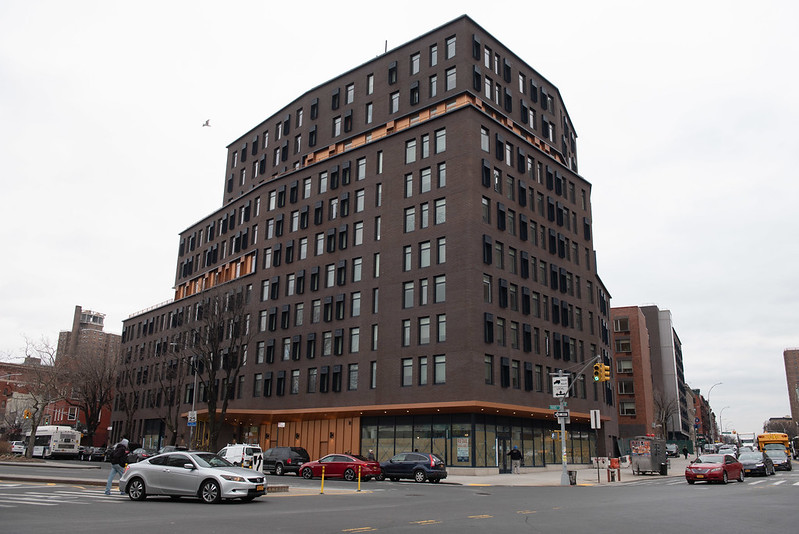
Housing (photo: Michael Appleton/Mayoral Photography Office)
If you live in a New York City apartment building, chances are you don’t use a traditional metal key to open the front door.
In recent years, countless residential buildings have converted to so-called “smart access” systems that rely on key fobs, pin codes, and smartphone apps for entry. These technologies can offer safety and convenience to residents.
They also pose a potential threat.
The reason is simple: every time a tenant taps their keyfob or enters their access code, it generates a piece of data that logs their entry.
What will your landlord do with this data? Will they use it to pry into your personal life? Will they sell it to marketers? Could it be used as an eviction tool? Will it be kept forever?
At present there are no laws that control how this data is used, in New York City or elsewhere in the nation. Your landlord is free to use this sensitive information however they please.
Time logs of when you or family enter the building could indicate patterns of work, travel, socializing, even walking the dog. This is no one’s business but your own.
Tenants need to know — with certainty — that the data generated by smart entry systems will never compromise their privacy and safety, nor make them vulnerable to abusive landlords bent on eviction.
That’s why we are fighting to pass legislation known as the Tenant Data Privacy Act (officially Intro. 1760) in the New York City Council. The bill is up for a vote in front of the full Council on Thursday, April 29.
The bill would prohibit landlords from ever using a tenant’s building entry data for purposes of eviction or harassment. It would also specifically ensure that smart access systems are never used to collect information on the relationship status of tenants and their guests.
The legislation ensures that a landlord can’t share entrance data with third parties without express permission from residents. The bill has extra protection for minors, to ensure that even the most basic information is not collected on them without explicit permission from a guardian.
And it obligates landlords to provide tenants, upon request, written policies about the type of data being collected, how long it’s kept, and the process for tenants to add additional household members or guests to the smart access system. And, critically, it requires that tenant data be permanently deleted after 90 days.
The bill also includes similar protections against misuse of utility data by landlords in buildings that track usage of heat, electricity, and Wi-Fi.
What about smart entry systems used not for the front door but the entrance to your apartment? Our law would mandate that tenants have a right to a traditional metal key for their personal unit if that’s what they prefer.
This law would have teeth: landlords would be liable for a penalty of up to $6,000 for each violation.
Yes there are benefits to smart entry systems. Traditional mechanical keys can be lost, stolen, or easily copied, creating safety concerns for neighbors. Tenants with an access system that uses a smartphone app are able to maintain a record of who enters their home and when and, in some cases, even have the ability to easily grant and revoke guest access.
This technology can also serve as a tool to detect if a super or other member of the building staff is entering your apartment without your consent. It can help domestic violence victims keep abusive partners out of their homes.
The Tenant Data Protection Act strikes a balance, allowing tenants the benefits of smart entry systems while protecting against the potential for abuse. The legislation has quickly gained momentum in the City Council, with 27 sponsors, and support from a growing coalition of tenants rights advocates and other leaders.
No one should ever worry that the simple act of opening their door could compromise their safety or privacy. We can and must take action now to keep tenants in New York City safe and vote to pass the Tenant Data Protection Act.
***
City Council Member Mark Levine represents District 7 and is Chair of the Council’s Health Committee. He is currently running for Manhattan Borough President. On Twitter @MarkLevineNYC.
***
Have an op-ed idea or submission for Gotham Gazette? Email This email address is being protected from spambots. You need JavaScript enabled to view it.
